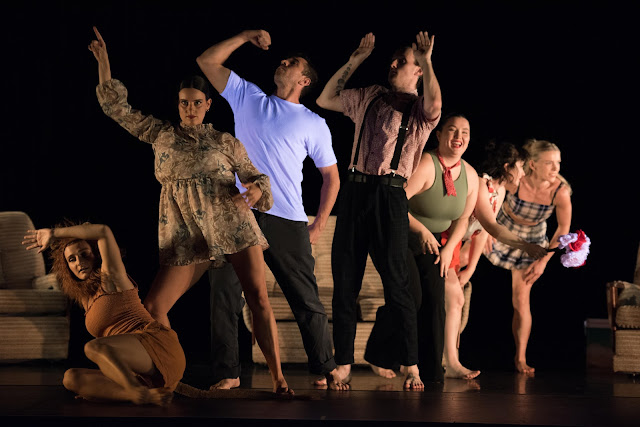 |
| Dancers of the Catapult Dance Choreographic Hub in "Awkward". |
Produced by
Adam Deusien – Directed and choreographed by Cadi McCarthy
Performed
by: Jordan Bretherton, Cassidy Clarke, Alexandra Ford, Nicola Ford, Romain
Hassanin, Remy Rochester, Anna McCulla
The B,
Queanbeyan Performing Arts Centre.
Performance
March 27th 2024 reviewed by BILL STEPHENS
 |
| The cast of "Awkward" |
This
performance of “Awkward” was presented in The B in the Queanbeyan Performing
Arts Centre, as the final stop in a regional tour taking in communities
including Candelo, Tathra and Bermagui. Although only a single performance it provided
an opportunity to experience the work of the Newcastle based Catapult Dance
Choreographic Hub, which was established by Cadi McCarthy in 2014 to provide opportunities
for mid-career and emerging choreographers, professional dancers and multi-disciplinary
artists.
McCarthy has
strong connections with the ACT Dance community, having established her own ACT
dance company, Cadi McCarthy & Company, in 2002. For this company she
created six full length works earning her Canberra Critics Circle Awards in
2004 and 2006. She has also created works for QL2 dance, most recently in 2022,
when she choreographed “Shifting Ground” for QL2’s mainstage production “Terra
Firma”.
Her
production of “Awkward”, which she choreographed and directed, is centred
around the premise of offering advice on dance party etiquette to the socially
awkward. It’s a promising idea which allows her an entertaining showcase with
which to demonstrate all the disciplines for which Catapult Dance Choreographic
Hub was established.
The touring
set is fairly minimal and arranged over two levels. A lounge suite occupies the
stage, while two drink bars along with an assortment of smaller properties are arranged
on floor level, providing plenty of room for the dancers. The seven dancers
wear costumes that suggest contemporary party wear, and the music is provided
by a sound system which the dancers are able manipulate at various points.
 |
| A moment during Catapult Dance Choreographic Hub's production of "Awkward". |
The work commences with the busy hostess cheerfully setting up the accoutrements for a successful party. One by one the guests arrive, each with a contribution, and all clearly and amusingly uncomfortable in the other’s presence. The hostess announces that she has the recipe to overcome this awkwardness, and her advice, often hilarious, is demonstrated by the dancers as she delivers it.
McCarthy’s
choreography is witty, inventive, very physical, and often acrobatic. She uses
the onstage furniture as an integral component of her choreography, requiring
the dancers to dance on, around, over and under it. In one uproarious episode
she has the hostess attempt to teach a male dancer some seriously silly disco
moves. Later the mood darkens when a section on alcohol use erupts into a fight
between two male dancers who engage in acrobatic fisticuffs before dissolving into
a haunting solo by one of them.
Unfortunately the lack of programs made it impossible to identify individual
dancers, which was a pity, because all were accomplished, and each shone in segments
built around their particular strengths.
But as
entertaining and accessible as this work is, at nearly 90 minutes, it would
benefit from some trimming and tightening to eliminate obvious choreographic repetition,
and a less shadowy lighting plot which often masked the work of dancers working
around the periphery of the stage area.
Images by Ashley de Prazer
This review also published in AUSTRALIAN ARTS REVIEW. www.artsreview.com.au


























